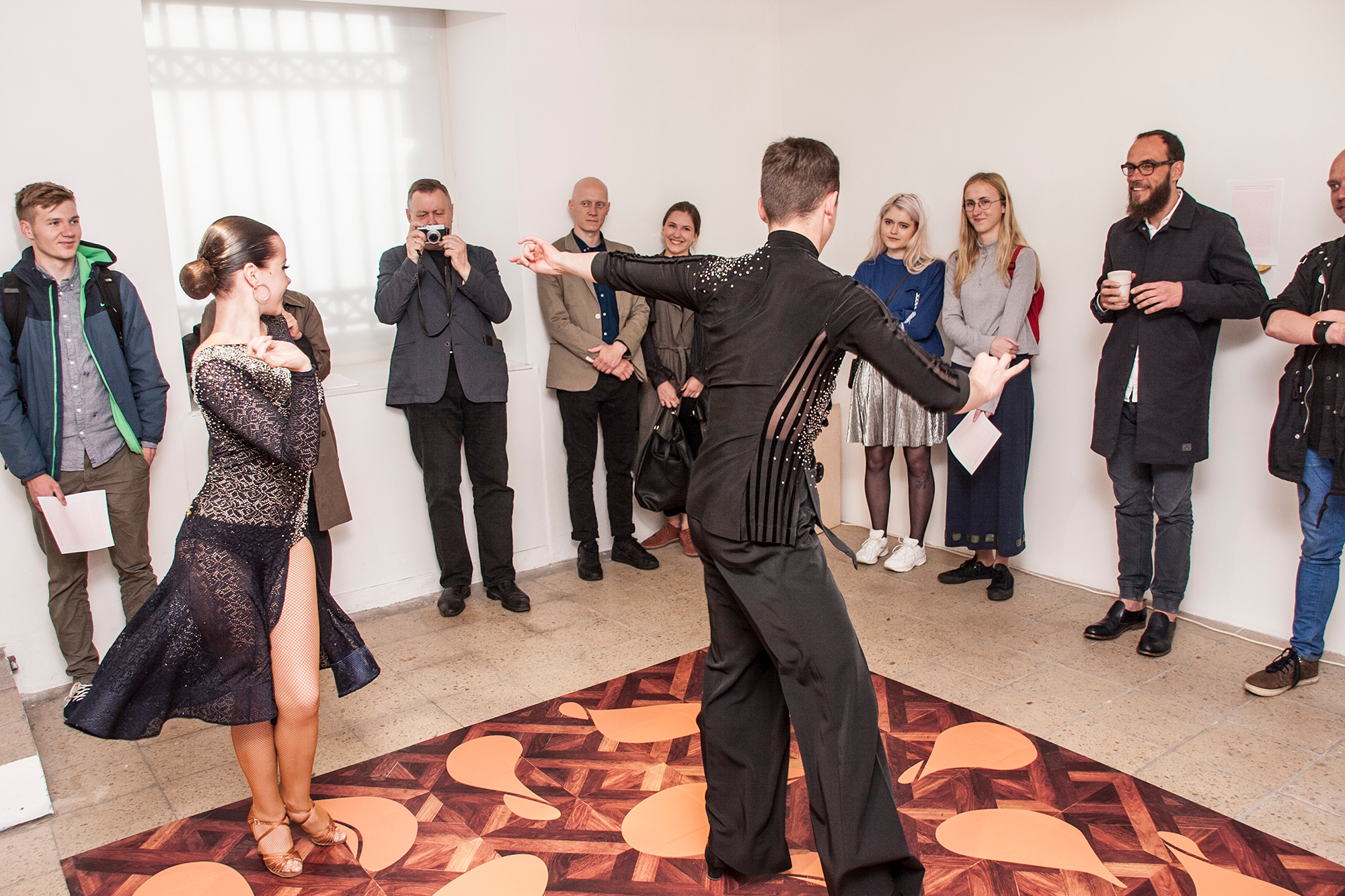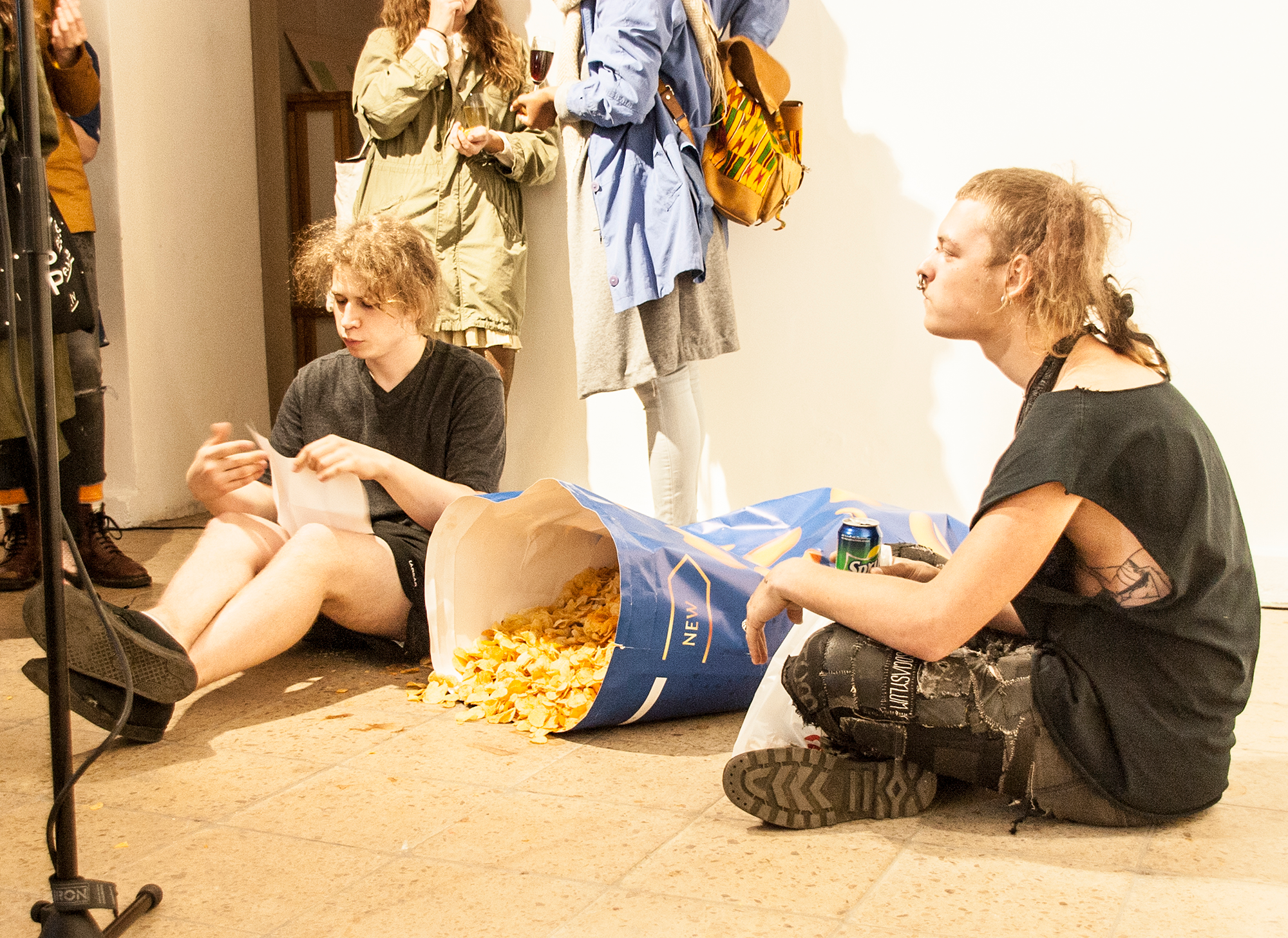How a Well-known Local Art Historian Called Me Fat When I Was Nine Years Old
dancing performance, mixed media installationMuch Better
Low Gallery, Riga, Latvia
21/06/2017
One night event in collaboration with Klāvs Mellis
Curated by Maija Kurševa
How a Well-known Local Art Historian Called Me Fat When I Was Nine Years Old
Every evening around midnight, wearing a semi-see through nightie, a well-known home-grown art historian crosses the eighteen square metres of the parquet floor in her bedroom, lies down on the left-hand side of her double bed, and slowly makes herself comfortable under her cool duvet blanket with its ascetically styled flower patterned cover. Imprinted, under the weight of her portly flesh on her aloe vera mattress, is the art historian’s silhouette. The cool blanket absorbs the warmth of her body and heart, while her tired brain succumbs to her nightly musings about the principal realms of her human experience: life, death and God. Looking back, very early on in her youth, the art historian thought that seventeen is something unreal. When she was eighteen, it seemed like life ended at thirty-three. Then she got to thirty-three, and it really did seem that life had ended. In turn, when the historian turned forty, she consciously started preparing for the moment when she would turn fifty. And - as foreseen - having reached a round fifty, things began to proceed smoothly of their accord. However, even now, on the rare occasions when an attractive young man addresses her in the formal plural, the well-known art historian feels suddenly feels as if she were already one hundred and fifty. Having wrapped herself up in her cool blanket, the art historian begins to think about all the men whom she’d met during the course of her life, and the time when she still young, attractive, and to some extent, sexy. Back then, she was not only an art historian, but also an art gymnast. With a certain degree of regret, the home-grown celebrity concludes that she still has a weakness of young, attractive and sexy men; the kind that sing pleasantly and look like boxers, not slim puppets as during the renaissance. The well-known art historian sleepily reflects on her students. Six days a week, she reads lectures on the history of art, design and the interior, Latvian painting prior to 1940, and on symbols and signs in contemporary culture. She is not only an associated professor, the also the curator of a theatre foyer art space. That one exhibition of Elita’s was really chic. Overall, in all sorts of situations, she remembers that the mesh that that actor Valters wrapped around himself. And the Russian actress Kruščkova is also charming. The art historian really likes theatre, but lately, it’s not been particularly interesting there, because, candidly speaking, she like old-time theatre. She doesn’t find all that contemporary stuff too interesting, but the art historian is not too distressed by this, because she knows that contemporaneity is only a passing phase. It’s not really the case that she likes absolutely everything, but nor is it the case that she wants to immerse herself in-depth into absolutely everything, but ultimately we’re now in a period of postpostpostmodernism, when it’s modern to quote everything, and, the result is akin to the kind of hotchpotch you encounter after a party, when all the left overs are tossed into the same bowl and mixed. Of course, if she’s a good cook, if we are interpreted with talent, then the result is more or less okay: now and then it turns out to be a mouth-watering experience, but if not, then, one has to admit that not even piglets would gobble up the contemporary hotchpotch on offer. However, that’s her job. Today, in order to be able to understand and perceive what’s going on the stage, in the fine arts, cinema and music, unfortunately you need to have deep knowledge of the context and the whole fat layer of cultural history that went before. The art historian really likes that director Ķimele. And in her book Ķimele wrote that currently artists are having the most difficult time, because that which existed before is so huge. For her part, the art historian can add that in reality, this is also quite a tough time for art historians. But everything in life tends to spiral out and everything is repeated, and nothing’s about to disappear. Thus thinks the well-known home-grown art historian as she falls asleep. She’s lying in bed. She’s covered with a blanket. In front of her is a fireplace and surrounding her - in fifteen or copies - are portraits of her with no clothes on painted by various artists. She imagines Venice and a small black evening dress. She recalls the harshness of capitalism and the fact that, in five years at the academy, she missed only two lectures. She has been happy for thirty-eight of her years on earth. Tried but happy. She recalled how Cardinal Pujāts returned from Rome and presented her with a VHS cassette showing the ceiling of the Sistine Chapel, and recalls the Works of Turner and Arcimboldo, and tiny, tiny Dutch still lifes. She slips into sleep and is a tad saddened by each trampled stem of grass, but now remembers that interactive television has been invented, which is quite nice, because you can wind up an archive there. She’s never really had any best mates. She remembers that she wanted to approach art; how she thanked the academy for the model, and she they spoiled her with kindness there. She remembers the truth. She recalls the snow queen, firstly the old one, then the new version, and then the new version, which wasn’t bad by the way. She sleeps on her back, sighs, and puts her hands together in a praying gesture on her breasts, and with her Aloe vera mattress scrunching under her restless flesh, sinks into deep and healthy sleep.
She has no recollection of our meeting in nineteen ninety-nine. At that time, this home-grown art historian worked for Latvian Television, and therefore she was distantly acquainted with my mom. Apparently, mom told her that I was into dancesport. I remember sitting in the waiting room on the sixth floor and eating crisps, when a woman I didn’t know came out of my mom’s office, crossed the corridor, walked past me, stopped, turned and asked, “You’re eating crisps?” This completely threw me, because she was a celebrity, who often appeared on TV. Politely, I offered the pack of crisps to the art historian. Having observed me with a trained and critical gaze, she smiled and concluded, “I’ve never seen such a fat dancer.”
Text by Klāvs Mellis






